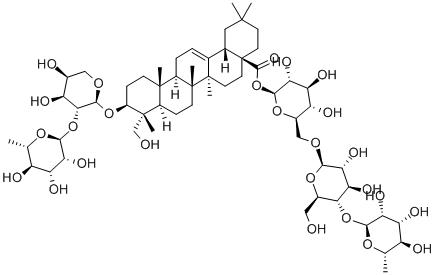Research progress in chemical constituents and pharmacological activities of Eucommia leaves
-
Last Update: 2020-04-03
-
Source: Internet
-
Author: User
Search more information of high quality chemicals, good prices and reliable suppliers, visit
www.echemi.com
Last revision: 2013-01-10 03:24 classification: efficacy effect: 0 people commented that Eucommia ulmoides Oliv is the dry bark of Eucommia ulmoides Oliv It has many functions such as tonifying the liver and kidney, strengthening the muscles and bones, reducing blood pressure, and calming the fetus Chinese Pharmacopoeia stipulated that its bark is used as the human medicine of Eucommia ulmoides Eucommia ulmoides Oliv is a national second-class rare tree species The bark of Eucommia ulmoides Oliv generally needs to grow for 15-20 years, while the leaf resources are relatively rich and easy to obtain Therefore, in recent years, scholars at home and abroad have made in-depth research on Eucommia ulmoides Oliv In this paper, the research progress of the chemical constituents and pharmacological activities of Eucommia ulmoides Oliv Leaves is briefly reviewed, providing theoretical basis for the deep development and utilization of this traditional Chinese medicine 1.1 lignans: including pinoresinol digluco side, the main antihypertensive component, eugenol diglucoside, olive oleoresin , geniposidic acid methyllester, catechin-1 (7,8b, c) - 4A - (3,4-dihydroxyphenyl) a (3H) pyranose, catechin-4 (7,8b, c) - 418 (3,4-dihydroxyphenyl), a (3H) pyranose [3, etc., many lignans have only good antitumor activity 1.2 iridoid terpenoids: eneommio1, encommio side, genipin, geniposidic acid, geniposide, aucubin, ajugoside, Harpagide acetate, repatoside [4], car Leaf oxalic acid, deacetylacetylacetic acid, Lo acetyl cauliflower glycoside, epieucommia alcohol 1.3 phenylpropanoid compounds: including 13 sistostero 1, ursolic acid, coumaric acid, ethyl caffeite acid ether, chlorogenic acid and syringin 1.4 flavonoids: kaempfero1, quercetin, astragalin, hirsutin and rutin 1.5 amino acids and microelements: including 17 kinds of free amino acids such as serine, glutamic acid, glycine and arginine, among which the essential amino acids are complete; there are 15 kinds of microelements such as Zn, Cu, Fe, Mn, GE and Xe 1.6 other ingredients: gutta percha is a trans isoprene polymer, 3,4-dihydrobenzoic acid, and ethy glucoside 2.1 cardiovascular effects: Zhang Liping et al Extracted the effective component of reducing blood pressure from Eucommia ulmoides Oliv The content in the skin is about three times higher than that in the leaves Eucommia leaf extract has a very obvious and lasting hypotensive effect on anesthetized cats The intensity of hypotensive increases with the increase of dose, and the duration of hypotensive is also prolonged In the study of human body experiment, 30 patients with hypertension took the compound Eucommia mixture for 4 weeks, the blood pressure decreased (15.33 ± 14.85) / (10.90 ± 10.66) mmHg on average, in which 9 cases were effective, 14 cases were effective, and the effective rate was 76.67% The difference between the two groups was significant (P < 0.05) The compound eucommia leaf mixture can obviously improve the symptoms of dizziness, palpitation, fidgety, and tenderness of knee and waist in patients with hypertension; it can significantly reduce the serum TC in the taking group and regulate the blood lipid The content of syringin in Eucommia ulmoides leaves is an inhibitor of angiotensin and camp, and can increase the coronary blood flow In addition, the content of water-soluble silicon and calcium is very high, which can participate in the regulation of cardiovascular function 2.2 effect of immune system: the 20% and 5 0% ethanol extracts of Eucommia ulmoides Oliv Leaves could significantly enhance the transformation of spleen lymphocytes and phagocytosis of peritoneal macrophages in mice, but had no significant effect on normal mouse antibody forming cells The ethanol extracts of Eucommia ulmoides Oliv Leaves and bark have the same immunopharmacological effect The ethanol extracts of Eucommia ulmoides Oliv Leaves can enhance the cellular immune function and non-specific immune function, but have no obvious effect on humoral immune function It is speculated that the ethanol extracts of Eucommia ulmoides Oliv Leaves may have some curative effect on diseases caused by the decrease of cellular immune function The extract of chloroform from the leaves of Eucommia ulmoides Oliv Is a kind of immunosuppressive substance which mainly interferes with the function of T lymphocyte 2.3 antagonizing the contraction of uterus caused by the posterior pituitary: the experimental method of isolated uterus smooth muscle of rats found that Eucommia yemangao had a certain effect on the normal contraction of uterus smooth muscle, but had a significant antagonism on the intense contraction of uterus smooth muscle caused by the posterior pituitary, and increased with the increase of dose, compared with the ratio of the posterior pituitary alone Compared with the control group, the contraction frequency and the activity decreased significantly Like progesterone, duzhongye granule has obvious antagonism to mice abortion caused by posterior pituitary, which can reduce the number of abortion animals and increase the number of offspring 2.4 anti-aging effect: mice were perfused with eucommia ulmoides leaves water extract (equivalent to crude drug 7.5, 15g KGI 1) twice a day for 8 weeks It was found that Eucommia ulmoides leaves water extract could significantly reduce the activity of SOD and GSH PX in the lung tissue of erythrocytes of aging model mice, and significantly inhibit them 1) The decrease of SOD and GSP PX induced by - galactose: the increase of MDA in lung tissue and erythrocytes induced by I - galactose was inhibited It is suggested that Eucommia ulmoides can enhance the scavenging effect of SOD on superoxide anion, strengthen GSH PX catalytic reduction of} {202, inhibit the oxidative damage of free radicals on the biofilm, reduce the production of MDA, and protect the integrity of cell membrane structure and function It was found that the leaves of Eucommia ulmoides could enhance the activity of superoxide dismutase and protect the lipid peroxidation of liver and muscle 2.5 inhibition of n-glucosidase activity: five n-glucosidase inhibitory components were isolated from eucommia tea ju3j after extraction with methanol, which can block or delay the production of glucose and intestinal absorption, so as to maintain the proper blood glucose value in vivo In addition, the expression of n-glucosidase on the cell surface after the transfer of sugar chain Recording also plays an important role in cell differentiation The methanol extract of Eucommia ulmoides can inhibit n-glucosidase by 92% and sucrase in rat intestine It can be seen that Eucommia ulmoides tea may be an ideal food therapy for diabetic and obese patients 2.6 the proliferation of osteoblasts: the extract of Eucommia ulmoides Oliv Can promote the proliferation of osteoblasts in vitro (osteoblast 0b) and the secretion of alkaline phosphatase (ALP) 2.7 antitumor effect: many lignans in Eucommia ulmoides leaves have high antitumor activity It has been reported that eugenol diglucoside has good activity in lymphocytic leukemia P388 (PS) system, the concentration is 12.5mg · kg, it can control t / C value ≥ 126; geniposide and geniposide also have antitumor activity According to the acute toxicity test, the maximum tolerance dose of Eucommia Leaf granules is 400 times of clinical daily dose, which indicates that the product is low toxicity and safe to take; the mutation test results of Eucommia Leaf: the eucommia leaf has no mutagenic effect on the standard test bacteria ta97a, TA98, talo0 and tal02, and the micronucleus test of mouse bone marrow cells and sperm abnormality test of mice are all negative Eucommia ulmoides Oliv is a kind of unique medicinal material in China, which has a long history of medicinal use and has a wide range of clinical applications Modern pharmacological research reports: the chemical composition and pharmacological effect of Eucommia ulmoides leaves are basically similar to that of cortex Because the resources are easier to obtain than Eucommia ulmoides, it has become a hot spot of pharmaceutical development, and has made many achievements, such as Eucommia capsule, Eucommia platen, Eucommia Zhuang Gu Wan, Eucommia Chong Ji, etc In Japan, Eucommia leaves are used as chicken feed additives to produce eggs with low cholesterol and high-density lipoprotein Eucommia leaves or their extracts are used to make a variety of Eucommia drinks and other health care drugs, which are used to fight against hypertension, hyperlipidemia and other diseases However, the clinical efficacy, preparation technology and quality standard of Eucommia leaves need to be further developed [1] Hu Shilin Some progress and trend of research on Eucommia ulmoides Oliv in foreign countries [J] Chinese herbal medicine in foreign medicine, 1994, 16 (5): 13.14 [2] Li Wenhong, Li Duowei, Zhang arpeng, et al Research on Extraction Technology of effective components in Eucommia ulmoides Oliv [J] Journal of Northwest University 1996, 26 (6): 372.375 [3] Zhao Yiwen Study on the inhibitory effect of eucommia tea on a-glucosidase activity and the separation of its main components [J] Chinese herbal medicine 1999, 30 (5): Appendix 1 [4] Wang Wenming, Pang Xiaoping, Cheng Jun, et al Overview of the chemical constituents of Eucommia [J] Northwest Pharmaceutical Journal 1998, 13 (2): 60-62 [5] Xu nuzhi Study on the iridoid terpenoids in Eucommia leaves [J] Foreign medicine Chinese herbal medicine 1998, 20 (5): 49 [6] Cheng Jun, Bai Yanjing, Zhao Yuying, et al Study on phenylpropanoids in Eucommia ulmoides leaves [J] Chinese Journal of traditional Chinese medicine 2002, 27 (1): 38-40 [7] Cheng Jun, Zhao Yuying, Cui Yuxin, et al Study on Flavonoids in Eucommia ulmoides leaves [J] Chinese herbal medicine Za Zhi 2000, 25 (5): 284.285 [8] Zang Youwei Research progress in chemical constituents of Eucommia ulmoides [J] Chinese herbal medicine 1989.20 (4): 42-44 [9] Wang Cailan, sun Ruixia, LV Wenying Dynamic determination of inorganic elements in Eucommia ulmoides leaves [J] Trace elements and health 1997, 14 (4): 33.34 [10] Okada n, shirata K, nwano m, et A1 I tivity of a monoterpene from Eucommia ulmoids [J] Chemistry, 1994, 37 (1): 281 [11] Zhang Liping, Xu Guo, Zhao Hongjie, et al Identification and analysis of antihypertensive components in Eucommia ulmoides leaves [J] Journal of mountain agricultural biology 2000.19 (3): 191-193 [12] Huang Wuguang, Zeng Qingzhuo, pan Zhengxing Et al Study on main pharmacodynamics and acute toxicity of Eucommia ulmoides leaves in sprint [J] Guizhou medicine 2000, 34 (6): 325.326 [13] Zhang Yingchao Zhang Yanmin, Guo daili Et al Experimental study on the antihypertensive effect of compound eucommia leaf mixture on human body [J] Chinese patent medicine 2001, 23 (6): 418.421 Xue Chengyuan Qu Fanxian [14] Liu Hui, et al Effect of ethanol extract of Eucommia leaf on immune function of mice [J] Journal of Gansu College of traditional Chinese medicine, 1998.15 (3): 50.52 [15] Zhou Huazhu Chen Cuihua, sun Huazhu Li, et al The effect of eucommia leaf extract on antioxidant function of aging mice [J] Journal of Xuzhou Medical College 1998.18 (6): 463.464 [16] Yin Jian, edited by Guo Ligong Modern research and clinical application of traditional Chinese medicine (1) [M] First edition Beijing: Science Press, 1993339-344 [17] Hu Jiajin Wang Manying Study on the metabolism function of Eucommia ulmoides leaves extract on osteoblasts cultured in vitro [J] Chinese Journal of basic medicine of traditional Chinese medicine 2001.7 (4): 288.290 [18] Yao Jiaxiang, Yao Jiachun, Shi Genyong Experimental study on mutation of Eucommia ulmoides leaves [J] Journal of Suzhou Medical College 1998:18 (6): 574-575 [19] Wang Benxiang, ed modern Chinese medicine pharmacology Tianjin: Tianjin Science and Technology Press [M] 19971259 [20] ran Maoxiong, Zhou houqiong Thoughts and suggestions on the deep development of Eucommia leaves [J] Chinese pharmacy 1998, 9 (5): 203.204
This article is an English version of an article which is originally in the Chinese language on echemi.com and is provided for information purposes only.
This website makes no representation or warranty of any kind, either expressed or implied, as to the accuracy, completeness ownership or reliability of
the article or any translations thereof. If you have any concerns or complaints relating to the article, please send an email, providing a detailed
description of the concern or complaint, to
service@echemi.com. A staff member will contact you within 5 working days. Once verified, infringing content
will be removed immediately.







